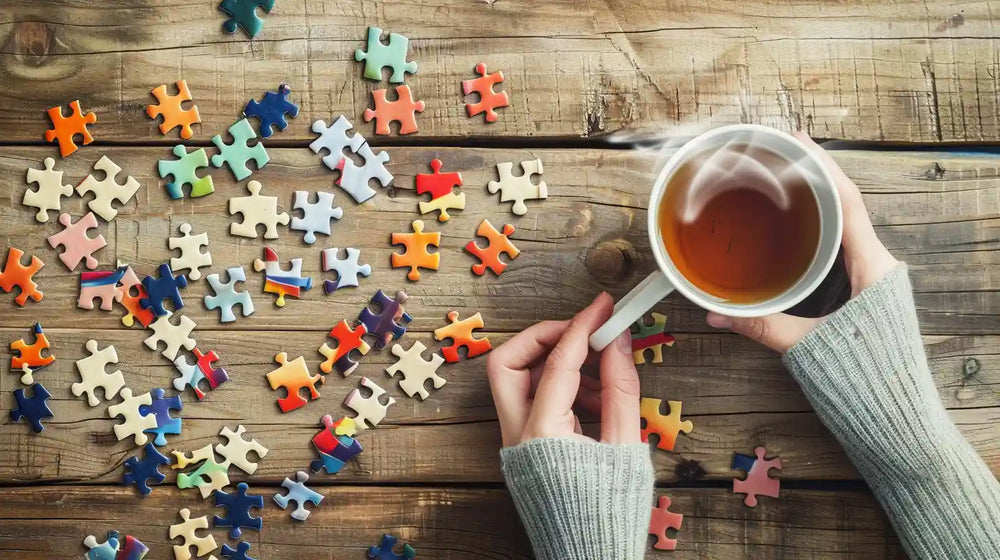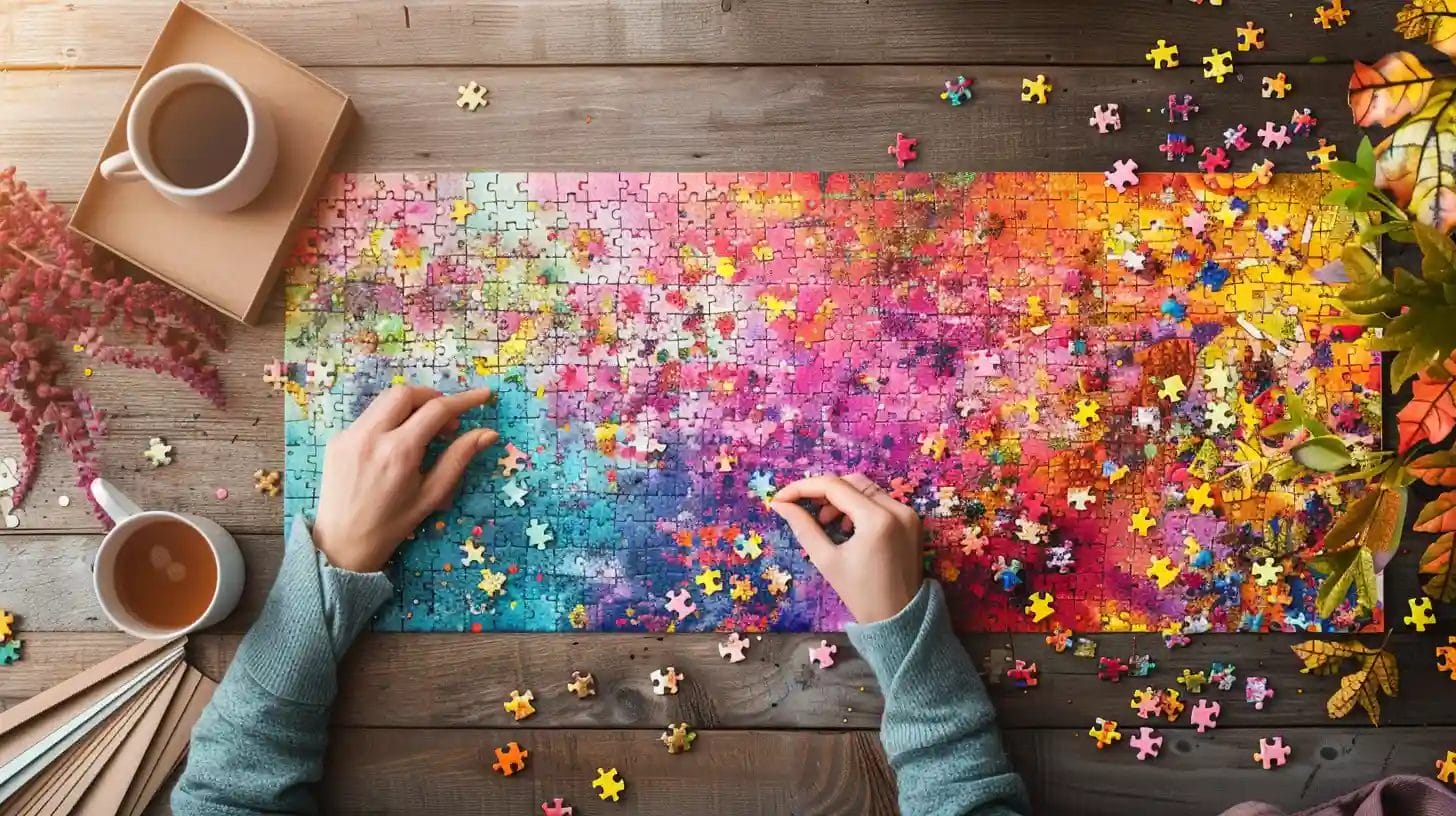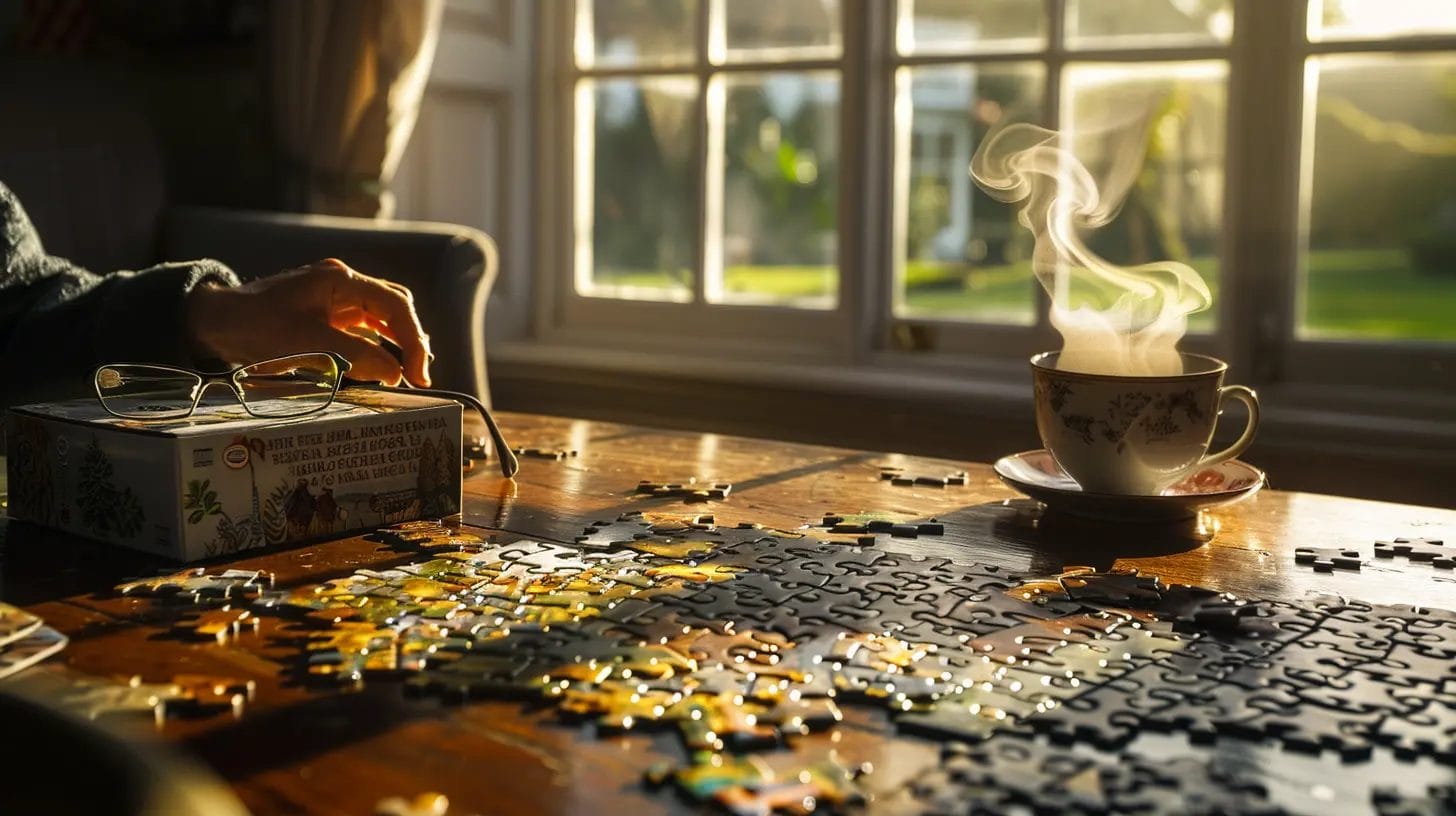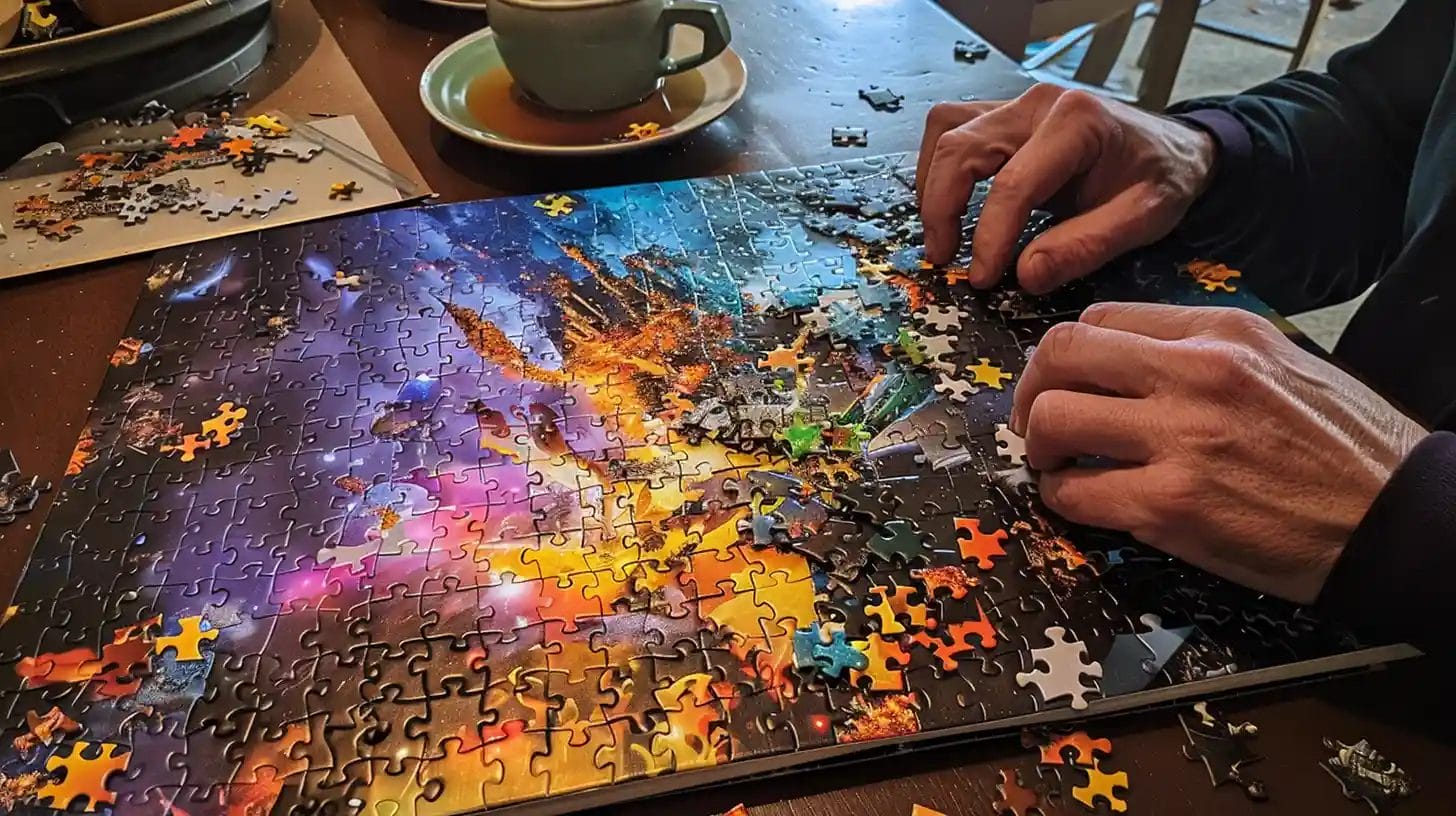
How to Start Puzzles: Tips and Tricks to Start a Jigsaw Puzzle Fast
You've decided to start a puzzle and might wonder where to begin. Choosing the right puzzle is essential. To ease into the process, opt for one with fewer than 500 pieces. Once selected, find a spacious, well-lit area and lay all the pieces face up. Sorting them by edges, colors, and patterns can enhance your efficiency.
As you build the border, you'll notice a framework forming, setting the stage for the more challenging inner sections. What's the best approach when you're stuck, and how can you avoid common pitfalls? There's much more to uncover.
Key Takeaways
- Choose a puzzle with high color variation and fewer than 500 pieces for a manageable challenge.
- Designate a spacious, well-lit area with a flat surface for assembling the puzzle.
- Sort pieces by color, shape, or pattern using trays or containers for organization.
- Begin assembling with edge pieces to create a clear framework for the puzzle.
- Use the reference image on the box to guide the shape and color matching during assembly.
How to Start Puzzles Effectively

When transitioning into the world of puzzles, it's crucial to understand the best practices for getting started effectively.
1. Best Way to Sort the Pieces
Dump your pieces and start the puzzle sorting process. Flip them all face up to enhance visibility and simplify the process.
Separate the edge pieces from the rest. They form the puzzle's border and provide a solid starting point.
As you sort the puzzle pieces, consider grouping them by color or pattern. Sorting by color lets you quickly identify sections that go together, speeding up the assembly process. To keep everything organized, use tools like sorting trays or containers.
2. How to Organize Your Workspace for Jigsaw Puzzles
Creating an ideal workspace is key to a smooth and enjoyable assembly process. Start by designating a spacious, well-lit area, ensuring plenty of room and visibility. A flat surface like a dining table or a dedicated puzzle board works best to accommodate your puzzle layout without interruptions.
Consider using a puzzle board with edges. These boards are easy to transport and store, allowing you to work on your puzzle without losing progress.
3. Assemble the Border First
The next step is deciding whether to assemble the border first. Tackling the border pieces can provide a stable framework for efficient assembly.
Identifying and connecting edge pieces creates a clear boundary that helps visualize the puzzle's overall layout. This makes it easier to organize the remaining interior sections. Corner pieces play a significant role here. They establish the puzzle's dimensions and orientation right from the start.
4. Choose a Suitable Puzzle Image
Choosing the right puzzle image can affect your enjoyment and success in assembling a jigsaw puzzle. When starting out, choose a suitable image with distinct patterns and high color variation. This makes it easier to identify and connect pieces.
Opt for puzzles with less than 500 pieces to ensure the challenge is fun, not frustrating. Engaging imagery keeps you motivated, so look for puzzles with themes you love.
Avoid solid-color or monochromatic designs, as they complicate piece matching. Focus on simpler images with recognizable elements that guide you through the process.
5. Set a Time Limit
Consider setting a time limit for each puzzling session to start a jigsaw puzzle effectively. Allocating 30 to 60 minutes per session helps maintain focus and motivation, preventing burnout.
Break the puzzle into manageable sections and assign a specific time frame to each one. This approach encourages steady progress, keeping the experience enjoyable.
Using a timer creates a sense of urgency, helping you stay engaged and track your efficiency as you tackle different sections. Celebrate small victories, like completing a quadrant within the set time limit, to boost morale and motivate you to keep going.
Best Puzzle Strategies for Completing a 1000 Piece Puzzle

Understanding these strategies can enhance your problem-solving skills and enjoyment as you prepare to tackle a 1,000-piece puzzle.
What Techniques Help with Assembling the Border?
Tackling the border of a 1000-piece puzzle can be challenging, but having a strategy will simplify the task. Start by sorting all the pieces to separate the edge pieces from the rest.
Identify the corner pieces first. Their two straight edges make them the most easily recognizable pieces. Use the reference image on the puzzle box to help you visualize the edges' shape and color.
To maintain a sturdy border structure, guarantee a snug fit for each connection. Once the border is complete, it serves as a framework, helping you visualize and organize the inner sections.
How to Approach the Rest of the Puzzle
With the border securely in place, it's time to complete the more intricate part of your 1,000-piece puzzle.
First, sort all the pieces by color and pattern to help identify distinct sections. This approach makes it easier to focus on areas with similar hues or designs.
Use visual cues from the reference image to guide your piece's placement. Rotate pieces to find the best fit, especially in complex sections.
As you work, connect completed areas gradually to build momentum. Remember to take regular breaks to refresh your perspective and avoid frustration, ensuring the experience remains enjoyable.
What Should You Do When You Get Stuck on a Puzzle?

When you're stuck on a puzzle, stepping away for a few minutes can refresh your mind and help you see things differently.
Is It Helpful to Step Away from the Puzzle?
Perseverance in solving a puzzle can sometimes yield diminishing returns. When you find yourself stuck, it's beneficial to step away from the puzzle.
Taking breaks allows your mind to reset, offering a fresh perspective that can enhance your problem-solving abilities. Engaging in a different activity during your break can stimulate creativity, potentially leading to new insights when you return to the puzzle.
This pause reduces mental fatigue and improves overall cognitive function.
Tips and Tricks to Keep Working on the Puzzle
Feeling frustrated on a puzzle can feel frustrating, but there are effective strategies to keep your momentum going.
Take a break to refresh your perspective. When you return, flip over all the pieces to spot hidden colors or patterns. Focus on assembling smaller sections with distinct colors or patterns, tackling the puzzle step-by-step. This approach can simplify the process and prevent you from feeling overwhelmed.
Don't hesitate to collaborate with others. Discussing strategies or assigning different sections can offer fresh insights. Use trial and error to experiment with piece placement.
Keep a positive mindset and celebrate small milestones. These tips and tricks help you keep working on the puzzle, turning frustration into fun and progress.
Common Mistakes to Avoid When Working on a Puzzle

After reviewing strategies for solving puzzles effectively, consider the typical missteps that could impede your progress.
How to Prevent Losing Pieces
Anyone who's worked on a jigsaw puzzle knows that losing pieces can twist a fun activity into a frustrating one. To prevent this, first establish a designated, clutter-free space. This minimizes the risk of pieces getting knocked off or misplaced.
Use sorting trays to organize pieces by color, edge, or pattern, making it easier to track everything. Avoid working in high-traffic areas or while multitasking, as distractions can lead to pieces being overlooked or lost.
Regularly scan your table for stray pieces, especially if you have curious pets or children. After each session, store pieces in their original box or a labeled bag, ensuring they stay together and are ready for your next puzzle adventure.
What Should You Not Do When Sorting the Pieces?
Amid puzzle excitement, it's common to overlook some essential steps that can simplify your sorting process.
- First, don't dump all pieces into a single pile without flipping them face up; it hampers efficiency.
- Make sure to separate corners early on, as neglecting this step complicates the initial assembly.
- Organization is key, so avoid sorting pieces randomly. Use a transparent system to easily find specific colors or patterns.
- However, don't spend excessive time on sorting if it doesn't improve your experience.
- Finally, take breaks during sorting to prevent fatigue and maintain sharpness in identifying the right pieces.
Conclusion
When starting a jigsaw puzzle, focus on choosing one that suits your skill level and enjoy the process. Organize your workspace and pieces to set a strong foundation. Begin with the border and gradually move inward, using color and pattern clues to guide you.
If you get stuck, take a break and return with fresh eyes. Practice regularly to improve your speed. Avoid rushing or forcing pieces. Remember, patience and enjoyment are key to a successful puzzle experience.
FAQs
What Is the Best Way to Start a Puzzle?
You should begin a puzzle by selecting a size appropriate for your skill level. Choose a colorful design, sort pieces face-up, and focus on the edges first. Create a dedicated space and use tools to enhance organization.
How Do You Start Putting Together a Puzzle?
You start putting together a puzzle by flipping all pieces face up. Sort them by edges, colors, or patterns. Do the border part of the puzzle first, then focus on distinct sections. Take breaks to keep motivation high. Enjoy the process!
How to Solve Puzzles for Beginners?
For a beginner puzzler, choose an easy 500-piece set. Find a spacious, well-lit area. Sort pieces face up, focusing on the edges first. Tackle sections by color or pattern, and celebrate small victories to stay motivated.